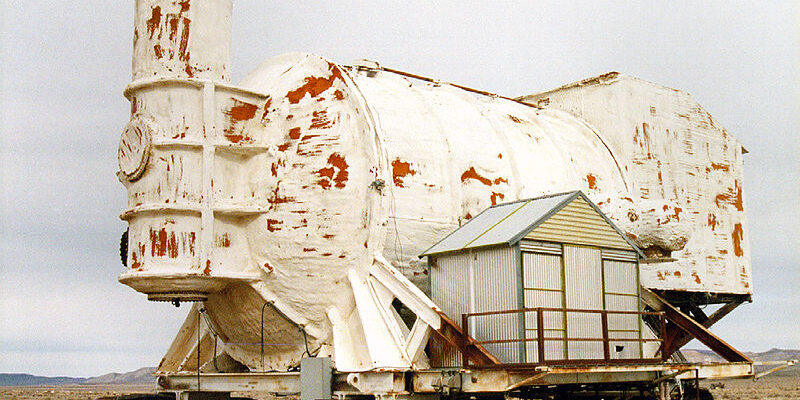Huron King Test Chamber, located to the right of 3-08 Road in Area 3, 600 meters from its original location. The Huron King test chamber contained a communications satellite and other space-related experiments, and simulated a space environment. It was used for a rare type of Vertical Line of Sight underground test conducted by the Defense Nuclear Agency, forerunner of the Defense Threat Reduction Agency. The device, which was less than 20 kilotons in yield, was detonated on June 24, 1980.
The Huron King test was intended to address concerns about how atmospheric nuclear detonation might affect military communication satellites in orbit. A nuclear explosion produces a large electromagnetic pulse, or EMP in short, that can be used by an enemy to inflict secondary damage upon electrical and electronic systems by generating high levels of current and voltage surges to burn out sensitive components such as semi-conductors. An electromagnetic bomb, can devastate and render functionless any modern society that rely on electricity by knocking out their power grid and disrupting communication equipment.
The Huron King test was conducted on 24 June 1980 as part of ‘Operation Tinderbox’. The objective was to measure and quantify the damage an EMP blast can inflict on a military satellite, and whether the shielding techniques used were adequate to deflect such an attack. Because atmospheric nuclear testing was prohibited, the engineers devised a novel solution—the test itself would take place underground, with a military communications satellite suspended directly over the exploding device. The satellite will be housed inside a giant 50-ton vacuum chamber built in order to simulate the vacuum of space. This vacuum chamber was nicknamed Tinderbox.
A 1,000-foot deep shaft was drilled and a 20-kiloton device was placed at the bottom of it. The Tinderbox, which was mounted on traction tread to make it movable, was parked at the top of the shaft and connected to the shaft by a vertical section. When the bomb detonated, radiation from the explosion shot up through the vertical shaft exposing the satellite to the electromagnetic pulse. A fraction of a second later, before the blast wave from the explosion could hit the Tinderbox and damage the target, mechanical closures sealed the shaft shut. The test chamber was immediately disconnected by remote control from the shaft and quickly winched to safety before the ground could subside to form a crater.
An inspection of the satellite after the test showed that the EMP shielding had worked as intended, and the satellite suffered no severe loss of functionality. The Huron King test cost USD 10.3 million in 1980 (equivalent to $35 million in 2020). The test chamber was never used again. You can still see it in satellite images (the site is off-limits to visitors) standing among the craters, 600 meters from its original location. It stands isolated in the middle of the Nevada desert, about 25 miles north of Mercury, a closed village and the gateway to the Nevada Test Site.
https://www.amusingplanet.com/2020/10/the-huron-king-nuclear-test.html

